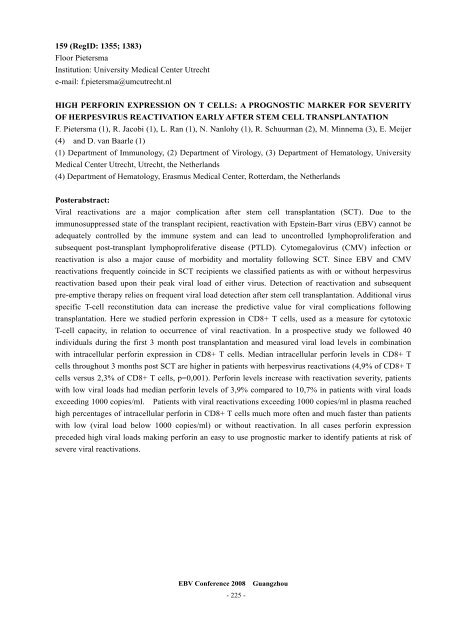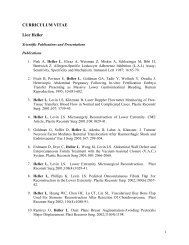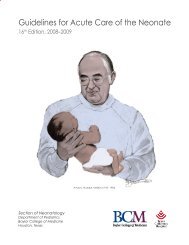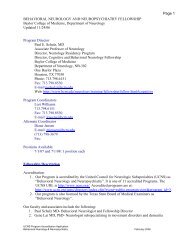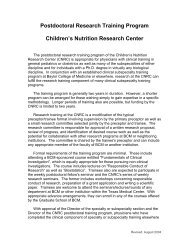EBV Conference 2008 Guangzhou - Baylor College of Medicine
EBV Conference 2008 Guangzhou - Baylor College of Medicine
EBV Conference 2008 Guangzhou - Baylor College of Medicine
You also want an ePaper? Increase the reach of your titles
YUMPU automatically turns print PDFs into web optimized ePapers that Google loves.
159 (RegID: 1355; 1383)<br />
Floor Pietersma<br />
Institution: University Medical Center Utrecht<br />
e-mail: f.pietersma@umcutrecht.nl<br />
HIGH PERFORIN EXPRESSION ON T CELLS: A PROGNOSTIC MARKER FOR SEVERITY<br />
OF HERPESVIRUS REACTIVATION EARLY AFTER STEM CELL TRANSPLANTATION<br />
F. Pietersma (1), R. Jacobi (1), L. Ran (1), N. Nanlohy (1), R. Schuurman (2), M. Minnema (3), E. Meijer<br />
(4) and D. van Baarle (1)<br />
(1) Department <strong>of</strong> Immunology, (2) Department <strong>of</strong> Virology, (3) Department <strong>of</strong> Hematology, University<br />
Medical Center Utrecht, Utrecht, the Netherlands<br />
(4) Department <strong>of</strong> Hematology, Erasmus Medical Center, Rotterdam, the Netherlands<br />
Posterabstract:<br />
Viral reactivations are a major complication after stem cell transplantation (SCT). Due to the<br />
immunosuppressed state <strong>of</strong> the transplant recipient, reactivation with Epstein-Barr virus (<strong>EBV</strong>) cannot be<br />
adequately controlled by the immune system and can lead to uncontrolled lymphoproliferation and<br />
subsequent post-transplant lymphoproliferative disease (PTLD). Cytomegalovirus (CMV) infection or<br />
reactivation is also a major cause <strong>of</strong> morbidity and mortality following SCT. Since <strong>EBV</strong> and CMV<br />
reactivations frequently coincide in SCT recipients we classified patients as with or without herpesvirus<br />
reactivation based upon their peak viral load <strong>of</strong> either virus. Detection <strong>of</strong> reactivation and subsequent<br />
pre-emptive therapy relies on frequent viral load detection after stem cell transplantation. Additional virus<br />
specific T-cell reconstitution data can increase the predictive value for viral complications following<br />
transplantation. Here we studied perforin expression in CD8+ T cells, used as a measure for cytotoxic<br />
T-cell capacity, in relation to occurrence <strong>of</strong> viral reactivation. In a prospective study we followed 40<br />
individuals during the first 3 month post transplantation and measured viral load levels in combination<br />
with intracellular perforin expression in CD8+ T cells. Median intracellular perforin levels in CD8+ T<br />
cells throughout 3 months post SCT are higher in patients with herpesvirus reactivations (4,9% <strong>of</strong> CD8+ T<br />
cells versus 2,3% <strong>of</strong> CD8+ T cells, p=0,001). Perforin levels increase with reactivation severity, patients<br />
with low viral loads had median perforin levels <strong>of</strong> 3,9% compared to 10,7% in patients with viral loads<br />
exceeding 1000 copies/ml. Patients with viral reactivations exceeding 1000 copies/ml in plasma reached<br />
high percentages <strong>of</strong> intracellular perforin in CD8+ T cells much more <strong>of</strong>ten and much faster than patients<br />
with low (viral load below 1000 copies/ml) or without reactivation. In all cases perforin expression<br />
preceded high viral loads making perforin an easy to use prognostic marker to identify patients at risk <strong>of</strong><br />
severe viral reactivations.<br />
<strong>EBV</strong> <strong>Conference</strong> <strong>2008</strong> <strong>Guangzhou</strong><br />
- 225 -


